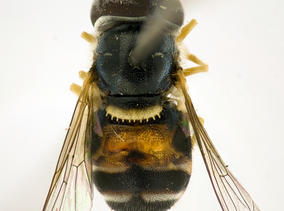You are here
Syrphidae
Paragus (Serratoparagus) crenulatus Thomson
Nomenclature
-
Genus: ParagusSubgenus: Paragus (Serratoparagus)
SUMMARY
Paragini, with the single genus Paragus, is a compact and distinctive group occurring in all continents other than South America and Antarctica. Paragus species are small, slender to moderately robust, with thorax black or with apex of scutellum pale, and abdomen usually extensively red-orange to entirely black. Paragus has postpronotum bare, antenna short, anterior anepisternum bare, abdomen parallel-side, face yellow in background colour, metaepisternum bare, scutum black laterally, at most with a poorly defined yellow polinose vitta, and metasternum bare.
The subgenus Serratoparagus sensu Vujic et al. (2008) has eyes with vittae of pile; face with distinct facial tubercle; scutum usually with long, submedian pollinose vittae reaching the posterior margin; scutellum with conspicuous teeth on posterior margin; spurious vein ending before meeting point of vein M1 with DM; abdomen short and elliptical; tergum 1 large, longer than distance between its posterior margin and the posterior margin of tergum 2; terga 1–5 completely fused, at least laterally; the posterior margins of terga 3 (female) and 4 (in both sexes) visible except laterally; male genitalia: minis large, lateral arms of minis short; epandrium in narrower part slightly shorter than or of same length as cercus; ejaculatory apodeme large, umbrella-like; lateral lobe of aedeagus strongly fused with aedeagal apodeme; aedeagus in ventral view ‘amphora-like’, very broad, petiolate basally; postgonite plate-like, pilose.






